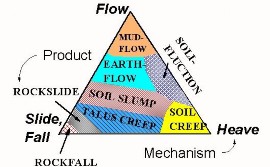5.3.2. Mass Movement
Mass movement or mass wasting is the term used for the movement of material down a slope under the influence of gravity. Thus it excludes those in which material is carried directly by a transporting medium such as running water, wind or ice. That means mass movement does not come under erosion though there is a shift of materials from one place to another. The movement of mass may range from slow to rapid, affecting shallow to deep columns of materials and include creep, flow, slide and fall. Weathering is not a pre-requisite for mass movement though it aids mass movement.
Mass wasting is viewed as a transitional phenomenon between weathering which is defined as occurring in situ and erosion which requires as one element transport by some agent. Mass wasting combines elements of both weathering and erosion.

Factors favouring mass movement are: (i) weathering; (ii) rock composition; (iii) texture and structure of material; (iv) slope gradient; (v) extent of lubrication. Several activities precede mass movements. They are : (i) removal of support from below to materials above through natural or artificial means; (ii) increase in gradient and height of slopes; (iii) overloading through addition of materials naturally or by artificial filling; (iv) overloading due to heavy rainfall, saturation and lubrication of slope materials; (v) removal of material or load from over the original slope surfaces; (vi) occurrence of earthquakes, explosions or machinery; (vii) excessive natural seepage; (viii) heavy drawdown of water from lakes, reservoirs and rivers leading to slow outflow of water from under the slopes or river banks; (ix) indiscriminate removal of natural vegetation.

